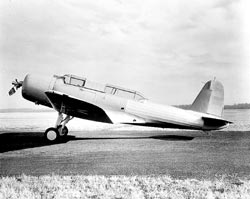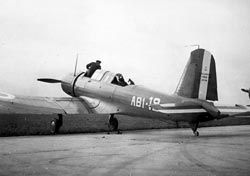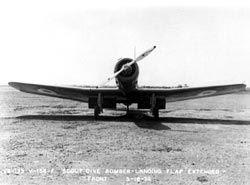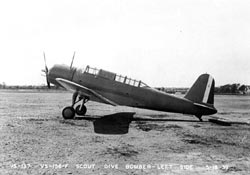|
 The threat of war in Europe led Vought to outfit an extra SB2U-2 airframe as a company demonstrator to seek export sales for the SB2U series in Europe. The aircraft was sent to Paris in October of 1938 where it was demonstrated for French officials. This demonstration led the French government, on February 22, 1939, to place a contract for 20 aircraft under the company designation V-156-F. The threat of war in Europe led Vought to outfit an extra SB2U-2 airframe as a company demonstrator to seek export sales for the SB2U series in Europe. The aircraft was sent to Paris in October of 1938 where it was demonstrated for French officials. This demonstration led the French government, on February 22, 1939, to place a contract for 20 aircraft under the company designation V-156-F.
While based on the earlier SB2U-2, the V-156-F featured a number of changes to meet the needs of the French Navy. The throttle was reversed so that it operated in the opposite way from U.S. standards (full power in the rearmost position) and metric instrumentation replaced U.S. instruments. French radio equipment was installed in place of American radios and French Darne 7.5-mm machine guns replaced the U.S. .30-caliber machine-guns. The French were not allowed to use the Vought bomb displacement gear (for security reasons) and it was deleted with the understanding that French Alkan equipment would be installed after the aircraft were delivered. By May of 1940 this equipment had still not been installed so most French V-156-F combat missions were carried out using only the underwing bomb racks. One other feature of the V-156-F was that wing-mounted fence-type dive brakes (rejected by the U.S. Navy) were installed on the V-156-F.
 During May of 1939, an additional order for 20 V-156-F’s was received by the Vought Company, and in June the first V156F rolled off the Vought assembly line. The first V-156-F’s arrived at LeHavre during July. They were off-loaded and transported to Orly Field in Paris for assembly and checkout. The first flight took place on August 6, and by the time hostilities began with Germany on September 3 there were thirty-four V-156-F’s in the inventory. Once the war broke out, the remaining V-156-F’s purchased by the French were shipped via Canada to avoid being embargoed under the U.S. Neutrality Act. During May of 1939, an additional order for 20 V-156-F’s was received by the Vought Company, and in June the first V156F rolled off the Vought assembly line. The first V-156-F’s arrived at LeHavre during July. They were off-loaded and transported to Orly Field in Paris for assembly and checkout. The first flight took place on August 6, and by the time hostilities began with Germany on September 3 there were thirty-four V-156-F’s in the inventory. Once the war broke out, the remaining V-156-F’s purchased by the French were shipped via Canada to avoid being embargoed under the U.S. Neutrality Act.
Escadrille AB1 on the carrier Bearn was the first French unit to fly the V-156-F’s. When the carrier was declared obsolete for war service, her squadrons were moved ashore. They were split into the first Flotille de Chasse (F1C), equipped with fighters and the first Flotille d’Attaque (F1A) consisting of AB1 and AB3, both flying the V-156-F. These units flew alongside AB2 and AB4, which flew Loire-Nieuport LN 401/411 dive-bombers.
 After AB1 received its full complement of 11 V-156-F’s it was deployed to Lanveoc-Poulmic to complete transition training. On reaching operational status, AB1 was moved to Alprecht, near Boulogne, on the Channel coast. From there, during November 1939, the squadron performed maritime patrols, and flew protection for allied convoys operating in the English Channel and the North Sea. The second French unit, AB3, was formed at Cherbourg on December 1, 1939. After AB1 received its full complement of 11 V-156-F’s it was deployed to Lanveoc-Poulmic to complete transition training. On reaching operational status, AB1 was moved to Alprecht, near Boulogne, on the Channel coast. From there, during November 1939, the squadron performed maritime patrols, and flew protection for allied convoys operating in the English Channel and the North Sea. The second French unit, AB3, was formed at Cherbourg on December 1, 1939.
The V-156-F received its “baptism of fire” on May 20, 1940 when AB1 was ordered to bomb a number of vital bridges that crossed a canal near Origny-Ste-Benoite on the Oise River. This attack was made in an attempt to slow down German armored units, even though the Navy pilots had no training or experience in attacking land targets. During this attack, the squadron was caught by a flight of Messerscmitt Bf-109E’s and lost five aircraft.
 The surviving V-156-F’s of AB1 participated in covering the Dunkirk evacuation that enabled some 338,226 British and Allied soldiers to reach the safety of England. From May 26 to June 4, AB1 attacked German armor and artillery with their remaining six V-156-F’s, with a loss of one aircraft. By the time France fell, the V-156-F had proven it could carry the fight to the enemy. While not a world-class dive bomber, it managed to get by mainly on the wits and courage of the men in the cockpit. AB3 was based at Cuers in the south of France and was attacking Italian targets during the waning days of the French war against the Axis powers. AB3 hit several targets in Northern Italy on June 14, 1940 when the squadron took off in two groups looking for targets of opportunity. The first group sighted an Italian submarine on the surface some twenty miles off Albenga. The four V-156-F’s made a perfect bomb run and scored two hits, sinking the submarine. The surviving V-156-F’s of AB1 participated in covering the Dunkirk evacuation that enabled some 338,226 British and Allied soldiers to reach the safety of England. From May 26 to June 4, AB1 attacked German armor and artillery with their remaining six V-156-F’s, with a loss of one aircraft. By the time France fell, the V-156-F had proven it could carry the fight to the enemy. While not a world-class dive bomber, it managed to get by mainly on the wits and courage of the men in the cockpit. AB3 was based at Cuers in the south of France and was attacking Italian targets during the waning days of the French war against the Axis powers. AB3 hit several targets in Northern Italy on June 14, 1940 when the squadron took off in two groups looking for targets of opportunity. The first group sighted an Italian submarine on the surface some twenty miles off Albenga. The four V-156-F’s made a perfect bomb run and scored two hits, sinking the submarine.
The next day six V-156-F’s were lost when Italian Fiat CR-42 biplane fighters attacked their base. On June 17 the surviving aircraft attacked Porto San Stefano Liguria. This was their last operational mission. After this mission the squadron was evacuated to Corsica and by August 30, 1940, the V-156-F’s were history.
|